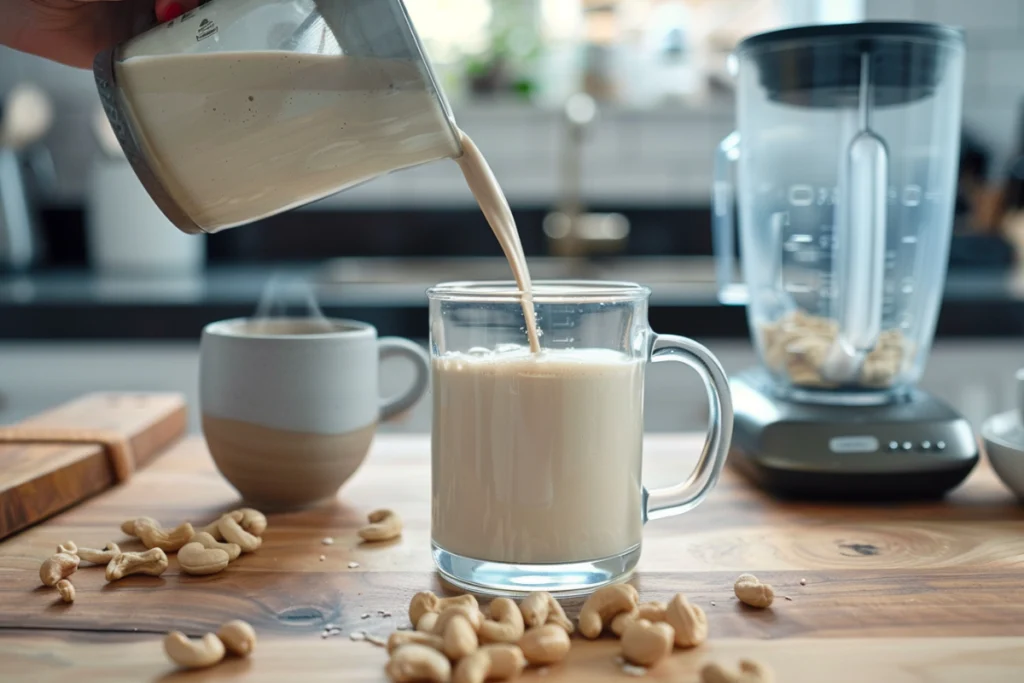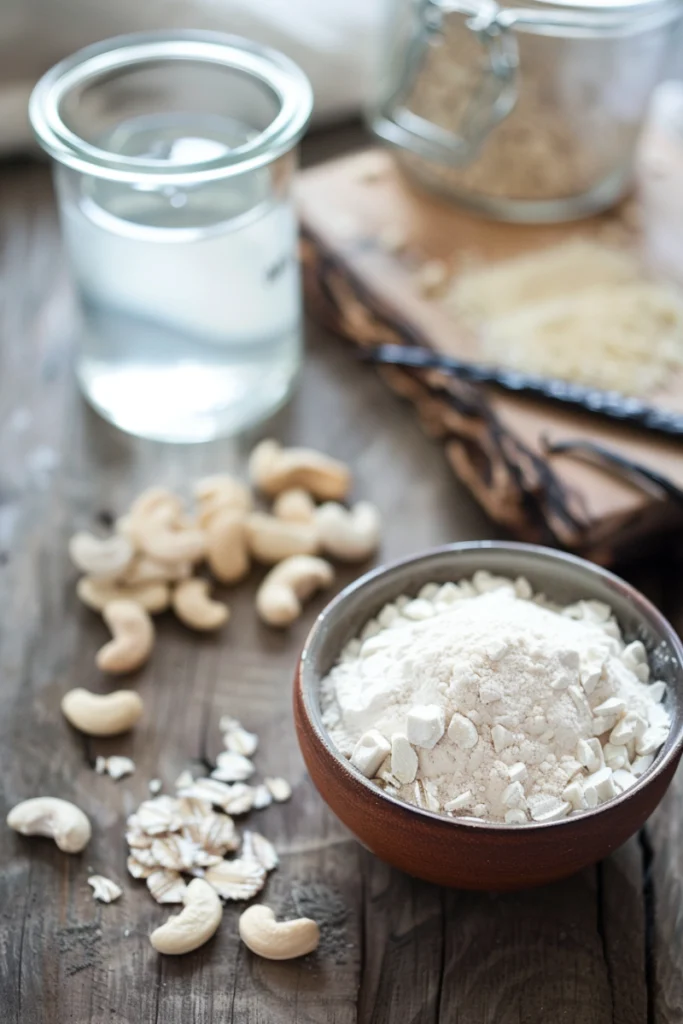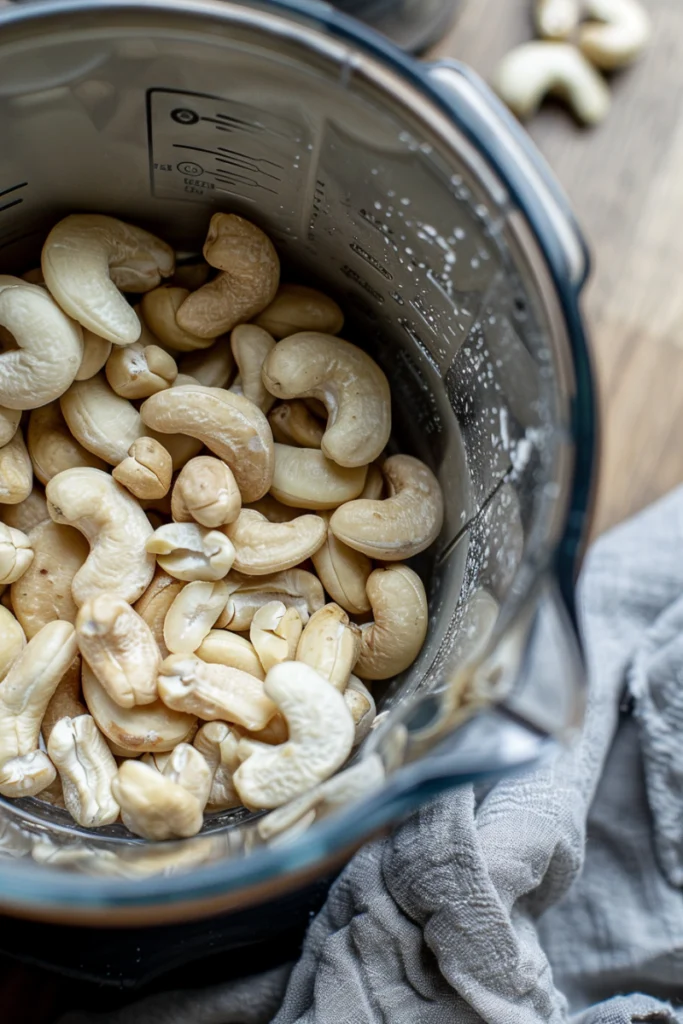
Learning how to make cashew milk at home is one of the easiest and healthiest choices you can make for your kitchen routine. This creamy, dairy-free drink isn’t just trendy—it’s a game-changer for vegans, the lactose-intolerant, and anyone cutting down on processed food. With only a few ingredients and no straining needed, homemade cashew milk is smoother, more flavorful, and customizable to your taste. Check out this guide on making Banana Oatmeal Smoothie at home if you’re exploring other plant-based options too.
What is Cashew Milk and Why Make It at Home?
The Rise of Dairy-Free Milk Alternatives
Making cashew milk has become a hot topic as more people ditch dairy and switch to plant-based milks. Whether it’s for health, environmental reasons, or ethical choices, plant-based beverages are now staples in millions of households. Unlike almond milk or soy milk, cashew milk offers a super creamy texture without needing to strain the pulp, making the process faster and less messy.
Cashew milk also aligns with the zero-waste lifestyle, since you use the whole nut. Compared to store-bought versions, homemade cashew milk contains no preservatives, gums, or added sugar—just clean, honest ingredients. And let’s be real, those cartons don’t come cheap. Once you try making your own, you’ll wonder why you didn’t start sooner.
Why Cashew Milk Is a Popular Choice
Making cashew milk is not only simple, but the results are impressively rich and smooth. Cashew milk is naturally sweeter than many nut milks, so it’s perfect for everything from lattes to cereal to cooking. It blends beautifully, which means no weird separation or chalky aftertaste.
Making cashew milk gives you full control over what goes into your drink. Want it thicker? Add fewer cups of water. Like it flavored? Throw in some vanilla or cinnamon. And with fewer carbs than oat milk and more creaminess than almond milk, cashew milk wins in both taste and texture.
Health Benefits of Homemade Cashew Milk

Nutritional Profile of Cashew Milk vs Dairy & Almond Milk
When you understand how to make cashew milk yourself, you gain full control over its nutritional content. Cashew milk is naturally low in calories yet rich in healthy monounsaturated fats, magnesium, copper, and plant-based protein. Unlike dairy, it’s cholesterol-free and easy on digestion, making it a smart option for people with lactose intolerance or sensitivities.
Compared to almond milk, homemade cashew milk has a slightly higher fat profile but offers more creaminess and body. Since you’re blending whole cashews, the final product retains more fiber and nutrients—no filtering, no waste. This makes learning how to make cashew milk an easy way to enhance your daily nutrition with clean, wholesome ingredients.
Key Health Benefits: Skin, Heart, and Weight Loss
From clearer skin to improved heart health, there are real wellness perks when you regularly use cashew milk. The copper in cashews promotes collagen production, which helps maintain firm, youthful-looking skin. Antioxidants combat oxidative stress, while the good fats in cashew milk support cardiovascular function by lowering LDL (bad cholesterol) and increasing HDL (good cholesterol).
Those trying to manage weight will find that knowing how to make cashew milk can be a game-changer. Its creamy texture is more satisfying than many other plant milks, helping you stay fuller longer. Plus, it’s naturally lower in carbs than oat milk, so it works well for people following low-carb or keto lifestyles.
Ingredients and Tools You’ll Need
Best Type of Cashews for Creamy Milk
For anyone eager to learn how to make cashew milk, it all starts with choosing the right cashews. Raw, unsalted cashews are essential—avoid roasted or salted varieties, as they can alter both the flavor and the texture of your milk. Organic, whole cashews work best because they blend more smoothly and yield a creamier consistency.
Using raw cashews also ensures that the final product is fresh and free of additives. While it may be tempting to buy bulk cashew pieces, the whole nuts usually result in better milk. If you’re serious about understanding how to make cashew milk that’s restaurant-quality, starting with premium ingredients is the key.
Must-Have Equipment: Blender, Strainer & Storage Tips
A high-speed blender is the most important tool in your quest to master how to make cashew milk. Since cashews are soft and blend easily after soaking, even a mid-range blender can do the job. However, a powerful blender will ensure ultra-smooth milk with zero grit or lumps.
You won’t need a nut milk bag or cheesecloth like you would with almond milk—just blend and pour. Still, if you prefer a smoother texture, a fine mesh strainer can help. When it comes to storing, glass jars or BPA-free containers with tight lids work best. Proper storage helps preserve freshness and prevents separation, both of which matter when you’ve taken the time to learn how to make cashew milk from scratch.
Step-by-Step Guide: How to Make Cashew Milk

– Soaking Cashews Correctly
Soaking is a crucial first step when figuring out how to make cashew milk that’s creamy and smooth. Place one cup of raw cashews in a bowl and cover them with water—ideally filtered. Let them soak for at least 4 hours, or overnight for the best results. This softens the nuts, making them easier to blend and helping to reduce any naturally occurring phytic acid, which can interfere with nutrient absorption.
If you’re short on time, a 15-minute quick soak in boiling water is a good backup. Still, long soaking is preferred for better flavor and creaminess. Many people who learn how to make cashew milk end up skipping this part, but it’s what separates gritty milk from silky perfection.
– Blending & Optional Flavor Additions
Once your cashews are soaked, it’s time to blend. Combine the cashews with 3 to 4 cups of filtered water in a high-speed blender. Blend on high for about 60–90 seconds until the mixture looks completely smooth. Unlike other nut milks, there’s no pulp to strain out—which is a huge bonus when you’re mastering how to make cashew milk at home.
Want to elevate the flavor? Add a pitted date or two for sweetness, a splash of vanilla extract, a pinch of sea salt, or even a dash of cinnamon or nutmeg. Some also like adding cocoa powder or maple syrup for variety. When you’re learning how to make cashew milk your way, these small touches go a long way toward making it a go-to staple in your fridge.
Customizing Your Cashew Milk
Sweetened vs Unsweetened Variations
One of the biggest perks of learning how to make cashew milk at home is customizing the sweetness to your taste. Store-bought nut milks often come loaded with sugar or artificial sweeteners. When you make your own, you get full control. Prefer unsweetened? Simply blend cashews and water—nothing else. For a naturally sweetened version, add a Medjool date, a drizzle of maple syrup, or a splash of agave.
Many who explore how to make cashew milk enjoy the flexibility of adjusting not only the sweetness but the texture too. Thicker milk for coffee? Use less water. Want it thinner for smoothies or cereal? Add more. It’s all up to you, and no two batches have to taste the same unless you want them to.
Flavor Infusions: Vanilla, Cocoa, Cinnamon & More
Once you’ve mastered how to make cashew milk in its purest form, you can start infusing it with flavors that match your cravings. A touch of vanilla extract transforms it into the perfect base for lattes or desserts. Cocoa powder turns it into a creamy, chocolatey treat. A pinch of cinnamon or turmeric? Now you’ve got a spiced nut milk that works great in baking or warm drinks.
These flavor infusions not only taste amazing but also enhance the nutritional profile. Cinnamon may help regulate blood sugar, while turmeric brings anti-inflammatory benefits. Learning how to make cashew milk this way lets you build variety into your plant-based lifestyle without spending more at the store.
Storing and Preserving Homemade Cashew Milk
How Long Homemade Cashew Milk Lasts in the Fridge
Once you’ve mastered how to make cashew milk, the next important step is knowing how to store it properly. Fresh cashew milk typically lasts 3 to 5 days in the refrigerator. Because it doesn’t contain preservatives like store-bought versions, it’s best to consume it quickly and store it in an airtight glass container or bottle.
Always label your jar with the date it was made. This simple habit helps avoid spoilage and ensures you always enjoy your milk at peak freshness. If you notice any sour smell, strange separation, or a slimy texture, it’s time to toss it and make a new batch. Those learning how to make cashew milk often overlook these details—but they’re crucial for food safety and flavor.
Can You Freeze Cashew Milk?
Another common question that pops up when people explore how to make cashew milk is whether it can be frozen. The short answer: yes, but with some caveats. Freezing is ideal if you’ve made a large batch and don’t want it to go to waste. Use freezer-safe glass jars or ice cube trays to portion out servings.
When thawing, cashew milk may separate, so it’s important to shake or re-blend it before using. Though the texture might be slightly different, the taste and nutritional value remain intact. Understanding how to make cashew milk also means knowing how to extend its shelf life smartly—especially if you’re making it part of your weekly routine.
Discover this easy guide on making Dubai chocolate to impress your family, and get more ideas for preparing your homemade pistachio cream.
Cashew Milk Recipe & Uses in Everyday Cooking

Using Cashew Milk in Coffee, Smoothies, and Sauces
Knowing how to make cashew milk opens the door to a wide range of tasty, dairy-free options in your everyday meals. Thanks to its rich, creamy texture, it’s the perfect non-dairy milk for coffee and lattes. It steams well, froths decently, and adds a slightly sweet, nutty flavor without overpowering your brew.
Smoothie lovers will appreciate how to make cashew milk part of their morning routine. Its thickness adds body to fruit blends, protein shakes, or green smoothies. It also works beautifully in savory dishes—think creamy pasta sauces, vegan Alfredo, or blended soups. Once you learn how to make cashew milk, you’ll find it replaces dairy effortlessly in dozens of recipes.
Baking and Cooking Ideas with Cashew Milk
One of the most underrated perks of learning how to make cashew milk is how well it performs in baking. You can use it in muffins, pancakes, quick breads, and even custards or puddings. It delivers moisture, mild flavor, and a soft texture without the heaviness of dairy milk.
In cooking, cashew milk can act as a base for mashed potatoes, risottos, or casseroles. It’s also ideal for vegan mac and cheese, where its natural creaminess shines. Once you know how to make cashew milk, it becomes a budget-friendly ingredient that elevates both sweet and savory recipes alike.
Don’t miss our rich and luxurious Dubai Chocolate Recipe—perfect for gifting, indulging, or impressing with every silky pistachio-filled bite.
Cashew Milk vs Other Plant-Based Milks
Comparing with Almond, Soy, and Oat Milk
Understanding how to make cashew milk gives you a unique advantage over other plant-based milk options. Compared to almond milk, cashew milk is thicker, naturally sweeter, and doesn’t require straining—saving both time and waste. While almond milk is a bit lower in fat, cashew milk wins in creaminess, making it a better fit for coffee or cooking.
Soy milk, on the other hand, has a higher protein content, but many people avoid it due to allergies or concerns about GMOs. If you’ve learned how to make cashew milk, you’re choosing a clean, whole-food option with fewer additives. And while oat milk is currently trending, it tends to be higher in carbs and sugar. Cashew milk offers a more balanced nutritional profile without the starchy aftertaste.
Which Plant Milk Is Best for You?
Choosing the best milk really depends on your dietary needs and preferences, but once you know how to make cashew milk, it’s easy to see why so many people prefer it. It’s ideal for keto, paleo, and dairy-free diets, and works in both sweet and savory dishes. If you’re watching calories but still want something satisfying and versatile, cashew milk is hard to beat.
What sets this milk apart is how easy it is to tailor to your exact taste. Whether you’re avoiding allergens, trying to reduce sugar, or simply want something homemade and wholesome, learning how to make cashew milk ensures you’re getting a fresh, chemical-free drink every time.
Discover great ideas like our easy Philadelphia Soft Pretzels Recipe that brings authentic street-style flavor to your kitchen with just a few simple ingredients and foolproof steps.
Common Mistakes & Troubleshooting Tips
Why Your Cashew Milk Separates or Tastes Off
Even after learning how to make cashew milk, small mistakes can lead to less-than-perfect results. One of the most common issues is separation. While a bit of settling is normal, excessive separation usually points to under-blending or not soaking the cashews long enough. To prevent this, always soak the cashews for at least 4 hours (or overnight), and blend for a full 60 to 90 seconds.
Odd flavors are another red flag. If your cashew milk tastes bitter or sour, check the quality of your cashews. Rancid or old nuts can ruin the batch. It’s also important to use filtered water to avoid adding unwanted minerals or flavors to the final product. Anyone learning how to make cashew milk should remember that fresh ingredients and proper technique make all the difference.
How to Fix Texture, Flavor, and Storage Issues
If your cashew milk is too thin or watery, the solution is simple: reduce the water-to-cashew ratio. A blend of 1 cup cashews to 3 cups water results in a thicker consistency. Want it creamier still? Try 2½ cups water instead. A high-speed blender also makes a big impact—grainy milk is often caused by underpowered blending.
When it comes to storage, proper containers matter. Always use a clean, airtight glass bottle and store it in the coldest part of your fridge. If separation still happens, a quick shake or stir brings everything back together. The more often you practice how to make cashew milk, the more intuitive these fixes become.
FAQs: cashew milk how to make
Is it cheaper to make your own cashew milk?
Yes—learning how to make cashew milk at home is almost always more affordable than buying it pre-made. Store-bought cashew milk can cost $4–$6 per carton, but homemade versions often cost half that, especially when buying cashews in bulk. Plus, you get more milk and no fillers, gums, or preservatives.
Do you need to soak cashews before making milk?
Absolutely. Anyone serious about how to make cashew milk should never skip soaking. Soaking softens the cashews, making them easier to blend and improving the milk’s texture. It also helps reduce anti-nutrients like phytic acid, which can block mineral absorption. Four hours is the minimum—overnight is ideal.
How long does homemade cashew milk last?
Properly stored in a sealed glass container, homemade cashew milk stays fresh in the fridge for 3 to 5 days. If you know how to make cashew milk, you’ll also know to shake it well before each use and always sniff it before pouring. Any sour smell or thick clumps? Time to toss it and blend a new batch.
Can I use roasted cashews for milk?
Technically, yes—but it’s not recommended. If you’re committed to how to make cashew milk that tastes fresh and smooth, stick to raw cashews. Roasted nuts can result in a bitter, smoky, or overpowering flavor. Raw cashews offer the cleanest, creamiest taste for plant-based milk.
Is cashew milk healthier than almond milk?
Yes, and that’s another reason to love learning how to make cashew milk. It heats well for lattes, hot chocolate, or cooking—without curdling like many other non-dairy milks. Just warm it gently over low heat and stir regularly. Avoid boiling, which can alter flavor and texture.
Conclusion:
Choosing to learn how to make cashew milk is more than just a kitchen experiment—it’s a lifestyle upgrade. It’s fast, affordable, and incredibly satisfying to create a rich, creamy plant-based milk with just two ingredients. You’ll skip the additives, customize the taste, and have a versatile staple for everything from lattes to lasagna.
Once you get into the rhythm of how to make cashew milk regularly, you’ll start saving money, reducing waste, and enjoying better-tasting dairy-free alternatives every day.
Don’t miss our Virgin Margarita Mocktail to explore more drinks.
Want to save this recipe on how to make cashew milk for later or share it with friends?
📌 Pin it on Pinterest
👍 Follow us on Facebook for more recipes!


